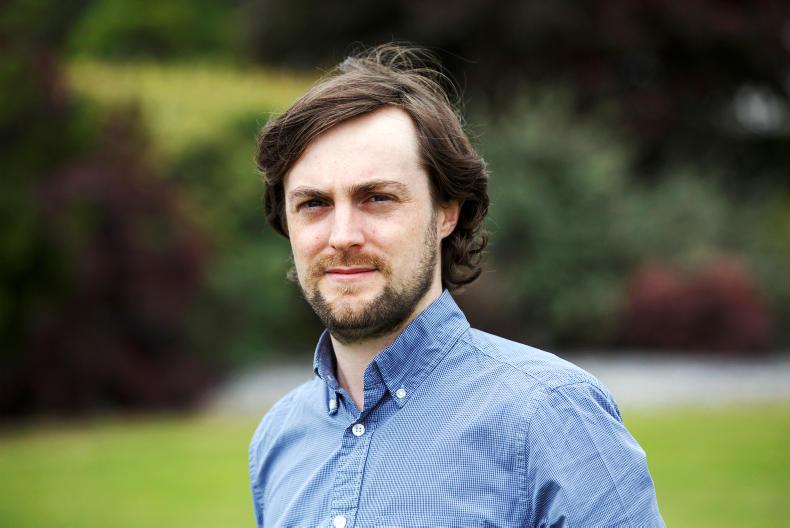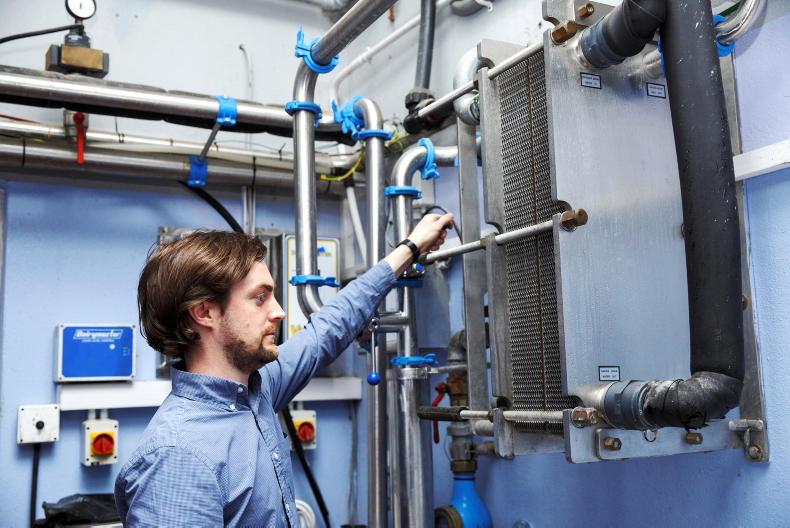Cork Institute of Technology (CIT) and Teagasc have launched a new decision support tool to help dairy farmers make better decisions about energy usage on their farms. The purpose is to inform farmers about what the payback period will be from investing in renewable and more energy efficient devices.

John Upton from Moorepark helped to design the decision support tool.Variable speed vacuum pumps, heat recovery systems, solar water heating, solar photovoltaic (PV) and wind turbines are some of the investments that the decision support tool covers. While all of these investments will reduce energy consumption and greenhouse gas emissions, the question farmers have is whether or not the extra investment will save them money in the long term.
The tool is available online at www.messo.cit.ie/dairy and is the brainchild of Michael Murphy from CIT and John Upton from Moorepark with support from the Sustainability Energy Authority of Ireland (SEAI).
A pilot programme was launched by SEAI last year grant aiding the retrofit of variable speed drive pumps on milking machines. Variable speed drives slow down the pump when the vacuum is stable, eg during milking, thereby saving electricity. Up to 50% grant aid was available and the programme was oversubscribed. A new scheme similar to the last one has just been announced.
In January of this year the government announced that it plans to grant aid Solar PV panels. While the full details have not yet been announced, it is expected that up to 40% of the investment cost of PV panels will be grant aided, but with no feed-in tariff. PV panels generate electricity from the sun’s rays. A feed-in tariff is where the government pays a fixed rate for electricity that is fed back to the grid.
This means that farmers won’t make money from generating surplus electricity, instead, any extra electricity generated will reduce electricity costs and CO2 emissions on the farm.
The main thing most farmers will be looking at will be the payback period for the investments, with shorter payback periods being more attractive. The payback period is largely dependent on the capital cost of the investment and how much energy it will save.
Speaking at the launch of the tool, John Upton said that milk cooling is the largest consumer of electricity on dairy farms at 29% of the total energy usage followed by water heating at 19.5% and milk harvesting at 18.5% of total energy usage. Installing a plate cooler to reduce the amount of cooling the bulk tank needs to do is one of the best and cheapest energy saving devices there is. After that, making maximum use of night rate electricity will also reduce costs.
Night rate electricity is half the cost per unit than flat rate or day rate. The amount of energy consumed at night rate is largely determined by milking times and the milk cooling system in place, with ice bank tanks being more energy efficient because they cool water at night and use the cold water to cool the milk during the day.
For variable speed drives, the payback period will be governed by the number of milking units relative to herd size. There will be a faster payback period where milking takes longer.
Future
It was said at the launch that energy companies are pushing the Energy Regulator to introduce peak pricing plans. These would further increase the cost of electricity at peak times, thereby introducing a third band, probably between 5pm and 7pm when demand for electricity is highest. This would increase electricity costs for dairy farmers because evening milking and milk cooling usually takes place during this time.
It is also likely that grant aiding for LED lights will be introduced as a measure in TAMS grants in the future. LED lights are more energy efficient than florescent lights and have a brighter, whiter colour and last longer, but are more expensive to install.
Read more
Grant scheme for dairy vacuum pumps to reopen
Monday management: lift in growth but rain returns
Cork Institute of Technology (CIT) and Teagasc have launched a new decision support tool to help dairy farmers make better decisions about energy usage on their farms. The purpose is to inform farmers about what the payback period will be from investing in renewable and more energy efficient devices.

John Upton from Moorepark helped to design the decision support tool.Variable speed vacuum pumps, heat recovery systems, solar water heating, solar photovoltaic (PV) and wind turbines are some of the investments that the decision support tool covers. While all of these investments will reduce energy consumption and greenhouse gas emissions, the question farmers have is whether or not the extra investment will save them money in the long term.
The tool is available online at www.messo.cit.ie/dairy and is the brainchild of Michael Murphy from CIT and John Upton from Moorepark with support from the Sustainability Energy Authority of Ireland (SEAI).
A pilot programme was launched by SEAI last year grant aiding the retrofit of variable speed drive pumps on milking machines. Variable speed drives slow down the pump when the vacuum is stable, eg during milking, thereby saving electricity. Up to 50% grant aid was available and the programme was oversubscribed. A new scheme similar to the last one has just been announced.
In January of this year the government announced that it plans to grant aid Solar PV panels. While the full details have not yet been announced, it is expected that up to 40% of the investment cost of PV panels will be grant aided, but with no feed-in tariff. PV panels generate electricity from the sun’s rays. A feed-in tariff is where the government pays a fixed rate for electricity that is fed back to the grid.
This means that farmers won’t make money from generating surplus electricity, instead, any extra electricity generated will reduce electricity costs and CO2 emissions on the farm.
The main thing most farmers will be looking at will be the payback period for the investments, with shorter payback periods being more attractive. The payback period is largely dependent on the capital cost of the investment and how much energy it will save.
Speaking at the launch of the tool, John Upton said that milk cooling is the largest consumer of electricity on dairy farms at 29% of the total energy usage followed by water heating at 19.5% and milk harvesting at 18.5% of total energy usage. Installing a plate cooler to reduce the amount of cooling the bulk tank needs to do is one of the best and cheapest energy saving devices there is. After that, making maximum use of night rate electricity will also reduce costs.
Night rate electricity is half the cost per unit than flat rate or day rate. The amount of energy consumed at night rate is largely determined by milking times and the milk cooling system in place, with ice bank tanks being more energy efficient because they cool water at night and use the cold water to cool the milk during the day.
For variable speed drives, the payback period will be governed by the number of milking units relative to herd size. There will be a faster payback period where milking takes longer.
Future
It was said at the launch that energy companies are pushing the Energy Regulator to introduce peak pricing plans. These would further increase the cost of electricity at peak times, thereby introducing a third band, probably between 5pm and 7pm when demand for electricity is highest. This would increase electricity costs for dairy farmers because evening milking and milk cooling usually takes place during this time.
It is also likely that grant aiding for LED lights will be introduced as a measure in TAMS grants in the future. LED lights are more energy efficient than florescent lights and have a brighter, whiter colour and last longer, but are more expensive to install.
Read more
Grant scheme for dairy vacuum pumps to reopen
Monday management: lift in growth but rain returns







 This is a subscriber-only article
This is a subscriber-only article












SHARING OPTIONS: